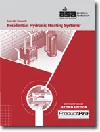Missing or misplaced hydronic equipment
The Glitch and The Fix, October 2014
The Glitch
After reading this month’s Hydronics Workshop column, an installer pipes up a system as shown below. The system uses a conventional gas-fired boiler to supply heat to a low-temperature radiant panel system.
Can spot several installation details that are incorrect or missing in the Glitch drawing above?
The Fix
Here a list of missing or misplaced details:
1. The conventional boiler has nothing to protect it against sustained flue gas condensation due to low entering water temperatures. These low temperatures could be caused by relatively cool water returning from the low-temperature distribution system or by cool water returning from the buffer tank.
2. There is no circulator between the motorized mixing valve and the manifold station. Because of this, there won’t be more than a trickle of flow through that manifold station.
3. The purging valve near the inlet to the boiler is installed backward and on the wrong side of the makeup water connection.
4. The internal check valve in the circulator leading to the buffer tank will prevent flow from moving from the tank to the inlet of the three-way mixing valve when necessary. Any heat from the buffer tank would only be available after flow passes through the boiler. Doing this when the boiler is off just uses the boiler as a heat dissipator. It’s a bad idea.
5. The piping leading into the top of the buffer tank will create a vertical flow jet that will mix the water in the tank, destroying temperature stratification.
6. There is no provision for venting air from the top of the buffer tank.
The Fix drawing above shows one way to remedy these shortcomings.
A high flow capacity, three-way thermostatic mixing valve is used to protect the boiler from low entering water temperatures.
The distribution system is connected close to the buffer tank with short and generously sized common piping to ensure good hydraulic separation of the circulators.
There are no check valves that prevent flow from passing from the buffer tank to the distribution subsystem.
A circulator is properly located between the three-way motorized mixing valve and the manifold station.
There is an automatic float-type air vent at the top of the buffer tank.
Water flows horizontally into the buffer tank to minimize any internal mixing.
Looking for a reprint of this article?
From high-res PDFs to custom plaques, order your copy today!







